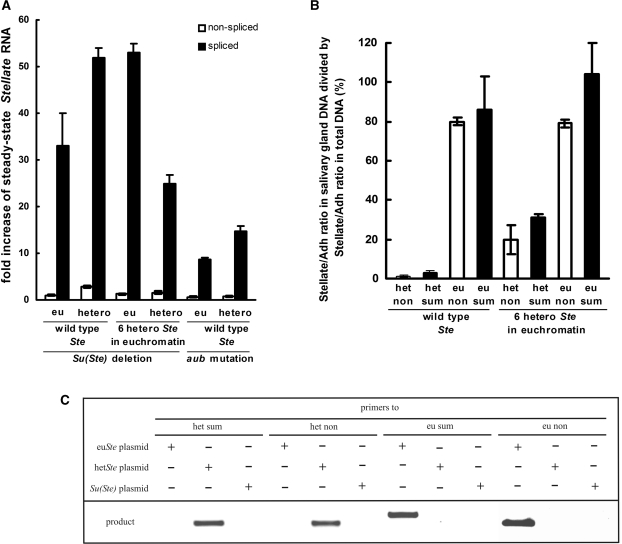Figure 1.
The effect of Su(Ste) repeats deletion or aub mutation on spliced and non-spliced Stellate mRNA abundance in the testes of Drosophila melanogaster. (A) Deletion of Su(Ste) repeats (compared with wild type) and the aubsting-1 (homozygous flies compared with heterozygous ones) lead to an increase of spliced euchromatic (eu) and heterochromatic (hetero) Stellate transcripts abundance (dark bars), but not nonspliced transcripts abundance (light bars). Quantitative RT-PCR was done using primers detecting either nonspliced (pairs of primers designated as eu non or het non in the text) or a sum of spliced and nonspliced Stellate transcripts (designated as eu sum or het sum). The quantity of spliced transcripts was calculated by subtracting the nonspliced transcript quantity from the sum. We were able to detect euchromatic and heterochromatic Stellate transcripts separately, since the 3′ end nucleotides of the primers were complementary to variants of single nucleotide polymorphisms, which distinguish types of Stellate genes (see Supplementary Data). The middle four bars show the effect of Su(Ste) deletion causing derepression of Stellate genes in the fly strain carrying a transgenic construct with six heterochromatic Stellate genes in the euchromatin of chromosome 3. (B) PCR analysis with plasmids carrying eu- or heterochromatic Stellate genes or a Su(Ste) repeat confirms primers specificity. (C) Verification of localization of detected Stellate copies. The diagram shows values, which correspond to the results of dividing the Stellate/Adh ratio in salivary gland DNA by the Stellate/Adh ratio in total DNA. This test confirms that het non and het sum or eu non and eu sum primers detect Stellate copies located in the hetero- or euchromatin, correspondingly. Using of fly strain with six heterocromatic Stellate genes in the euchromatin leads to increasing of the values for primers specific to heterochromatic Stellate genes confirming validity of the test.

